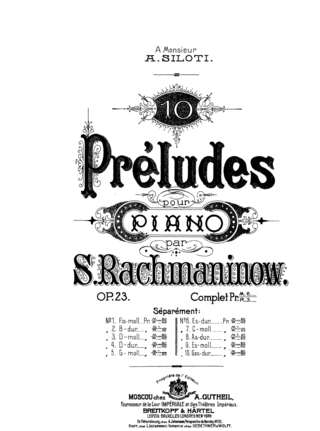
Alexander Nikolayevich Scriabin was a Russian composer and virtuoso pianist. Before 1903, Scriabin was greatly influenced by the music of Frédéric Chopin and composed in a relatively tonal, late Romantic idiom. Later, and independently of his influential contemporary, Arnold Schoenberg, Scriabin developed a much more dissonant musical language that had transcended usual tonality but was not atonal, which accorded with his personal brand of metaphysics. Scriabin found significant appeal in the concept of Gesamtkunstwerk as well as synesthesia, and associated colours with the various harmonic tones of his scale, while his colour-coded circle of fifths was also inspired by theosophy. He is often considered the main Russian Symbolist composer and a major representative of the Russian Silver Age.
A prelude is a short piece of music, the form of which may vary from piece to piece. While, during the Baroque era, for example, it may have served as an introduction to succeeding movements of a work that were usually longer and more complex, it may also have been a stand-alone piece of work during the Romantic era. It generally features a small number of rhythmic and melodic motifs that recur through the piece. Stylistically, the prelude is improvisatory in nature. The term may also refer to an overture, particularly to those seen in an opera or an oratorio.
In music, the mystic chord or Prometheus chord is a six-note synthetic chord and its associated scale, or pitch collection; which loosely serves as the harmonic and melodic basis for some of the later pieces by Russian composer Alexander Scriabin. Scriabin, however, did not use the chord directly but rather derived material from its transpositions.
The Piano Sonata No. 10, Op. 70, was written by Alexander Scriabin in 1913. It was his final work in this form. The piece is highly chromatic and tonally ambiguous like Scriabin's other late works, although arguably less dissonant than most of his late works. It is characterized by frequent trills and tremolos. It is sometimes called his "Insect Sonata", referring to his words:
Sergei Rachmaninoff's Prelude in C-sharp minor, Op. 3, No. 2, is one of the composer's most famous compositions. Part of a set of five piano pieces titled Morceaux de fantaisie, it is a 62-bar prelude in ternary (ABA) form. It is also known as The Bells of Moscow since the introduction seems to reproduce the Kremlin's most solemn carillon chimes.
F-sharp minor is a minor scale based on F♯, consisting of the pitches F♯, G♯, A, B, C♯, D, and E. Its key signature has three sharps. Its relative major is A major and its parallel major is F-sharp major.

G-sharp minor is a minor scale based on G♯, consisting of the pitches G♯, A♯, B, C♯, D♯, E, and F♯. Its key signature has five sharps.
Alexander Scriabin's Prelude, Op. 49, No. 2 is the second of his Trois Morceaux Op. 49, which were written in 1905. It is notated in F major, 3/4 measure, with a speed of 69 per quarter note, and lasts for 23 measures. It should be expressed Bruscamente irato.
Alexander Scriabin's Prelude Opus 51 No. 2 is the second of his Quatre Morceaux op. 51, published in 1906. It is notated in A minor. It is written in a 6/8 beat in 30 measures and should be expressed Lugubre (dire).
The Piano Sonata No. 6, Op. 62, by Alexander Scriabin was composed in 1911. Although it was named the sixth sonata, the piece was preceded by the Sonata No. 7. As it is one of the late piano sonatas of Scriabin's career, the music consists of a single movement and is almost atonal, although it is sometimes listed as being in the key of G. Scriabin reportedly never played the sonata in public, because he feared its darkness.
Alexander Scriabin's Prelude, Op. 74, No. 2, entitled Très lent, contemplatif, is one of five preludes in Op. 74, composed in late 1914.
The Piano Sonata No. 1 in F minor, Op. 6, by Alexander Scriabin, was the third of twelve piano sonatas that he composed. It was completed in 1892. The music is emotionally charged as much of the music was written after Scriabin had damaged his right hand through excessive piano playing.

Ten Preludes, Op. 23, is a set of ten preludes for solo piano, composed by Sergei Rachmaninoff in 1901 and 1903. This set includes the famous Prelude in G minor.

Thirteen Preludes, Op. 32, is a set of thirteen preludes for solo piano, composed by Sergei Rachmaninoff in 1910.

Leonid Leonidovich Sabaneyev or Sabaneyeff or Sabaneev was a Russian musicologist, music critic, composer and scientist. He was the son of Leonid Pavlovich Sabaneyev, a famous hunting expert, and his brother Boris was also a musician.
The Prelude Op. 28, No. 4 by Frédéric Chopin is one of the 24 Chopin preludes. By Chopin's request, this piece was played at his own funeral, along with Mozart's Requiem.

Rêverie, Op. 24, is an orchestral work composed by Alexander Scriabin in 1898. A typical performance lasts from 3 to 5 minutes. Scriabin, who was a pianist, had never before composed for orchestra, except for a few unpublished works. However, he composed the work in total secrecy, without any advice.

There is a long tradition in classical music of writing music in sets of pieces that cover all the major and minor keys of the chromatic scale. These sets typically consist of 24 pieces, one for each of the major and minor keys.
Alexander Scriabin's 24 Preludes, Op. 11 is a set of preludes composed in the course of eight years between 1888–96, being also one of Scriabin's first published works with M.P. Belaieff in 1897, in Leipzig, Germany, together with his 12 Études, Op. 8 (1894–95).
In music, Op. 59 stands for Opus number 59. Compositions that are assigned this number include:






